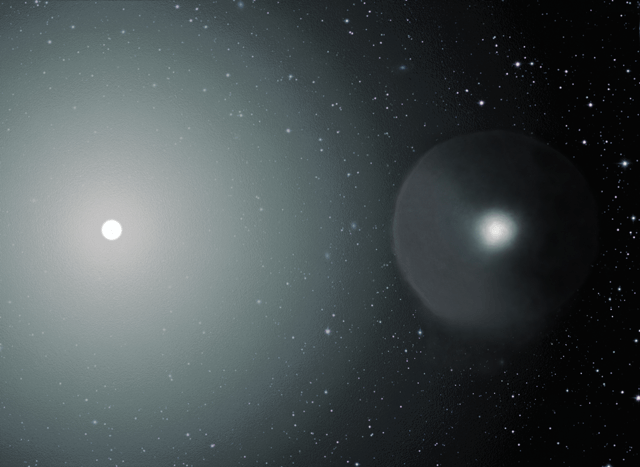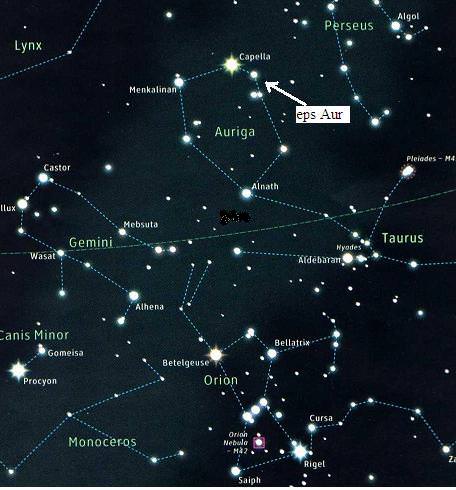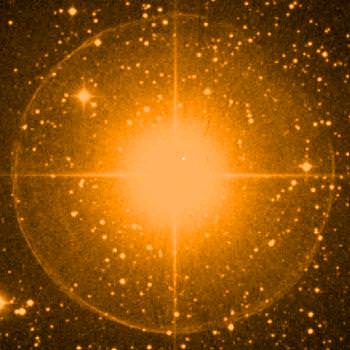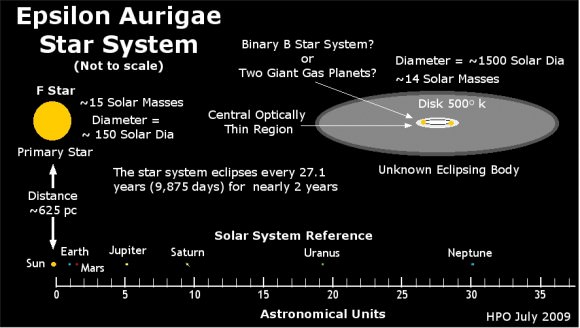Epsilon Aurigae has baffled astronomers since the 1800’s, but new images are providing insight into this very unusual eclipsing binary star. While eclipsing binary stars aren’t unique in themselves, the way this star fades and then regains its brightness is inimitable and has not been fully understood, even after over 175 years of study. One theory has been that a large opaque disk seen nearly edge-on eclipses the primary star. The new images from an instrument developed at the University of Michigan appear to confirm that theory. “It kind of blows my mind that we could capture this,” said John Monnier from U-M. “There’s no other system like this known. On top of that, it seems to be in a rare phase of stellar life. And it happens to be so close to us. It’s extremely fortuitous.”
Epsilon Aurigae has a two-year-long eclipse that occurs every 27 years. The current eclipse started in August 2009 and amateur and professional astronomers have taken this opportunity to train as many telescopes on the event as possible.
Monnier led the development of the Michigan Infra-Red Combiner (MIRC) instrument, which uses interferometry to combine the light entering four telescopes at the CHARA array at Georgia State University and amplify it so that it seems to be coming through a device 100 times larger than the Hubble Space Telescope. MIRC allowed astronomers to “see” the eclipsing object for the first time.
The object that eclipses the primary star is dark — almost invisible — and is only seen as it passes in front of Epsilon Aurigae, the fifth brightest star in the northern constellation Auriga. Because astronomers hadn’t observed much light from it, one theory is the object was a stellar mass black hole. But the prevailing theory labeled it a smaller star orbited edge-on by a thick disk of dust. The theory held that the disk’s orbit must be in precisely the same plane as the dark object’s orbit around the brighter star, and all of this had to be occurring in the same plane as Earth’s vantage point. As unlikely as this alignment would be, it explained the observations.
The new images show that this is indeed the case. A geometrically thin, dark, dense, but partially translucent cloud can be seen passing in front of Epsilon Aurigae.
“This really shows that the basic paradigm was right, despite the slim probability,” Monnier said, and the disk appears much flatter than recent modeling from the Spitzer Space Telescope suggests. “It’s really flat as a pancake,” he said.
[/caption]
While the “movie” of the disk passing in front of the star looks eerily like Saturn’s rings, Monnier doesn’t think the object is like a ring system.
“Ring systems are generally (always) quite sparsely populated and not optically thick,” Monnier said in an email to Universe Today. “Also ring systems have virtually no gas and settle into *extremely* thin layers. Both of these facts make it highly unlikley that the dust Eps Aur is in a “ring” because it wouldn’t be able to completely absorb so much of the star light during eclipse. That said, we don’t know much about the distribution — there might be a bit of a central hole as indicated by brightening of the star during mid-eclipse seen in the past.”
As to why this object is so dark, Monnier said, “At this epoch we are seeing the back side that can’t do any reflecting. We would expect some light to scatter off at other times in the orbit and would be worth looking for but requires very high angular resolution and high dynamic range. Note that the disk is not completely dark — the infrared glow of the cool dust grains have been seen in the 1980s and most recently in a Spitzer space telescope paper by Hoard et al.” (See the paper, “Taming the Invisible Monster: System Parameter Constraints for Epsilon Aurigae from the Far-Ultraviolet to the Mid-Infrared.”
MIRC has also allowed astronomers to see the shape and surface characteristics of stars for the first time. Previously, stars were mere points of light even with the largest telescopes.
“Interferometry has made high resolution imaging of distant objects a reality,” said Fabien Baron, a post-doctoral researcher at U-M who helped with the imaging in this study. “It most probably will solve many mysteries but also raise many new questions.”
The new findings will be published in the April 8 edition of Nature. Researchers from the University of Denver and Georgia State University also contributed to the research.
Sources: EurekAlert, email exchange with John Monnier





